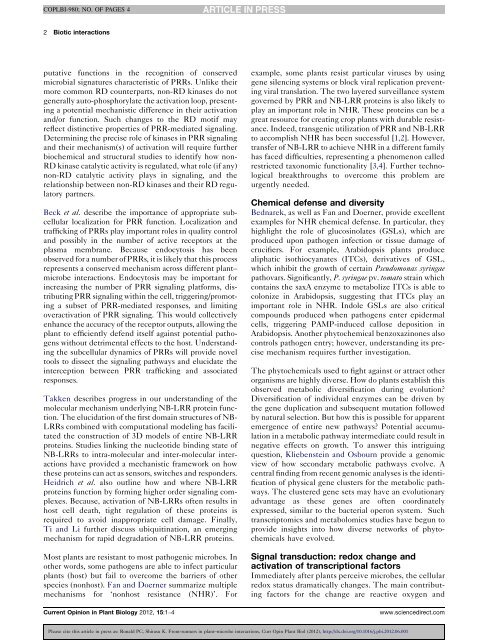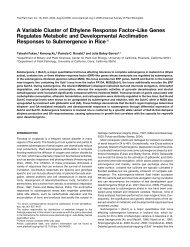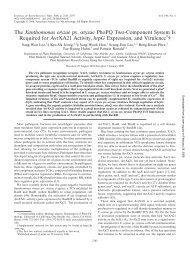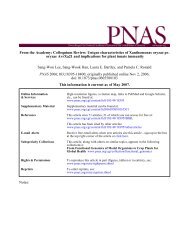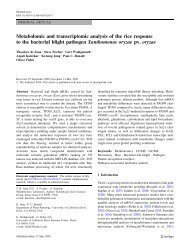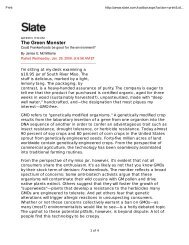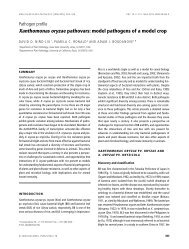Front-runners in plant–microbe interactions - Pamela Ronald
Front-runners in plant–microbe interactions - Pamela Ronald
Front-runners in plant–microbe interactions - Pamela Ronald
- No tags were found...
Create successful ePaper yourself
Turn your PDF publications into a flip-book with our unique Google optimized e-Paper software.
COPLBI-980; NO. OF PAGES 4<br />
2 Biotic <strong>in</strong>teractions<br />
putative functions <strong>in</strong> the recognition of conserved<br />
microbial signatures characteristic of PRRs. Unlike their<br />
more common RD counterparts, non-RD k<strong>in</strong>ases do not<br />
generally auto-phosphorylate the activation loop, present<strong>in</strong>g<br />
a potential mechanistic difference <strong>in</strong> their activation<br />
and/or function. Such changes to the RD motif may<br />
reflect dist<strong>in</strong>ctive properties of PRR-mediated signal<strong>in</strong>g.<br />
Determ<strong>in</strong><strong>in</strong>g the precise role of k<strong>in</strong>ases <strong>in</strong> PRR signal<strong>in</strong>g<br />
and their mechanism(s) of activation will require further<br />
biochemical and structural studies to identify how non-<br />
RD k<strong>in</strong>ase catalytic activity is regulated, what role (if any)<br />
non-RD catalytic activity plays <strong>in</strong> signal<strong>in</strong>g, and the<br />
relationship between non-RD k<strong>in</strong>ases and their RD regulatory<br />
partners.<br />
Beck et al. describe the importance of appropriate subcellular<br />
localization for PRR function. Localization and<br />
traffick<strong>in</strong>g of PRRs play important roles <strong>in</strong> quality control<br />
and possibly <strong>in</strong> the number of active receptors at the<br />
plasma membrane. Because endocytosis has been<br />
observed for a number of PRRs, it is likely that this process<br />
represents a conserved mechanism across different plant–<br />
microbe <strong>in</strong>teractions. Endocytosis may be important for<br />
<strong>in</strong>creas<strong>in</strong>g the number of PRR signal<strong>in</strong>g platforms, distribut<strong>in</strong>g<br />
PRR signal<strong>in</strong>g with<strong>in</strong> the cell, trigger<strong>in</strong>g/promot<strong>in</strong>g<br />
a subset of PRR-mediated responses, and limit<strong>in</strong>g<br />
overactivation of PRR signal<strong>in</strong>g. This would collectively<br />
enhance the accuracy of the receptor outputs, allow<strong>in</strong>g the<br />
plant to efficiently defend itself aga<strong>in</strong>st potential pathogens<br />
without detrimental effects to the host. Understand<strong>in</strong>g<br />
the subcellular dynamics of PRRs will provide novel<br />
tools to dissect the signal<strong>in</strong>g pathways and elucidate the<br />
<strong>in</strong>terception between PRR traffick<strong>in</strong>g and associated<br />
responses.<br />
Takken describes progress <strong>in</strong> our understand<strong>in</strong>g of the<br />
molecular mechanism underly<strong>in</strong>g NB-LRR prote<strong>in</strong> function.<br />
The elucidation of the first doma<strong>in</strong> structures of NB-<br />
LRRs comb<strong>in</strong>ed with computational model<strong>in</strong>g has facilitated<br />
the construction of 3D models of entire NB-LRR<br />
prote<strong>in</strong>s. Studies l<strong>in</strong>k<strong>in</strong>g the nucleotide b<strong>in</strong>d<strong>in</strong>g state of<br />
NB-LRRs to <strong>in</strong>tra-molecular and <strong>in</strong>ter-molecular <strong>in</strong>teractions<br />
have provided a mechanistic framework on how<br />
these prote<strong>in</strong>s can act as sensors, switches and responders.<br />
Heidrich et al. also outl<strong>in</strong>e how and where NB-LRR<br />
prote<strong>in</strong>s function by form<strong>in</strong>g higher order signal<strong>in</strong>g complexes.<br />
Because, activation of NB-LRRs often results <strong>in</strong><br />
host cell death, tight regulation of these prote<strong>in</strong>s is<br />
required to avoid <strong>in</strong>appropriate cell damage. F<strong>in</strong>ally,<br />
Ti and Li further discuss ubiquit<strong>in</strong>ation, an emerg<strong>in</strong>g<br />
mechanism for rapid degradation of NB-LRR prote<strong>in</strong>s.<br />
Most plants are resistant to most pathogenic microbes. In<br />
other words, some pathogens are able to <strong>in</strong>fect particular<br />
plants (host) but fail to overcome the barriers of other<br />
species (nonhost). Fan and Doerner summarize multiple<br />
mechanisms for ‘nonhost resistance (NHR)’. For<br />
example, some plants resist particular viruses by us<strong>in</strong>g<br />
gene silenc<strong>in</strong>g systems or block viral replication prevent<strong>in</strong>g<br />
viral translation. The two layered surveillance system<br />
governed by PRR and NB-LRR prote<strong>in</strong>s is also likely to<br />
play an important role <strong>in</strong> NHR. These prote<strong>in</strong>s can be a<br />
great resource for creat<strong>in</strong>g crop plants with durable resistance.<br />
Indeed, transgenic utilization of PRR and NB-LRR<br />
to accomplish NHR has been successful [1,2]. However,<br />
transfer of NB-LRR to achieve NHR <strong>in</strong> a different family<br />
has faced difficulties, represent<strong>in</strong>g a phenomenon called<br />
restricted taxonomic functionality [3,4]. Further technological<br />
breakthroughs to overcome this problem are<br />
urgently needed.<br />
Chemical defense and diversity<br />
Bednarek, as well as Fan and Doerner, provide excellent<br />
examples for NHR chemical defense. In particular, they<br />
highlight the role of glucos<strong>in</strong>olates (GSLs), which are<br />
produced upon pathogen <strong>in</strong>fection or tissue damage of<br />
crucifiers. For example, Arabidopsis plants produce<br />
aliphatic isothiocyanates (ITCs), derivatives of GSL,<br />
which <strong>in</strong>hibit the growth of certa<strong>in</strong> Pseudomonas syr<strong>in</strong>gae<br />
pathovars. Significantly, P. syr<strong>in</strong>gae pv. tomato stra<strong>in</strong> which<br />
conta<strong>in</strong>s the saxA enzyme to metabolize ITCs is able to<br />
colonize <strong>in</strong> Arabidopsis, suggest<strong>in</strong>g that ITCs play an<br />
important role <strong>in</strong> NHR. Indole GSLs are also critical<br />
compounds produced when pathogens enter epidermal<br />
cells, trigger<strong>in</strong>g PAMP-<strong>in</strong>duced callose deposition <strong>in</strong><br />
Arabidopsis. Another phytochemical benzoxaz<strong>in</strong>ones also<br />
controls pathogen entry; however, understand<strong>in</strong>g its precise<br />
mechanism requires further <strong>in</strong>vestigation.<br />
The phytochemicals used to fight aga<strong>in</strong>st or attract other<br />
organisms are highly diverse. How do plants establish this<br />
observed metabolic diversification dur<strong>in</strong>g evolution<br />
Diversification of <strong>in</strong>dividual enzymes can be driven by<br />
the gene duplication and subsequent mutation followed<br />
by natural selection. But how this is possible for apparent<br />
emergence of entire new pathways Potential accumulation<br />
<strong>in</strong> a metabolic pathway <strong>in</strong>termediate could result <strong>in</strong><br />
negative effects on growth. To answer this <strong>in</strong>trigu<strong>in</strong>g<br />
question, Kliebenste<strong>in</strong> and Osbourn provide a genomic<br />
view of how secondary metabolic pathways evolve. A<br />
central f<strong>in</strong>d<strong>in</strong>g from recent genomic analyses is the identification<br />
of physical gene clusters for the metabolic pathways.<br />
The clustered gene sets may have an evolutionary<br />
advantage as these genes are often coord<strong>in</strong>ately<br />
expressed, similar to the bacterial operon system. Such<br />
transcriptomics and metabolomics studies have begun to<br />
provide <strong>in</strong>sights <strong>in</strong>to how diverse networks of phytochemicals<br />
have evolved.<br />
Signal transduction: redox change and<br />
activation of transcriptional factors<br />
Immediately after plants perceive microbes, the cellular<br />
redox status dramatically changes. The ma<strong>in</strong> contribut<strong>in</strong>g<br />
factors for the change are reactive oxygen and<br />
Current Op<strong>in</strong>ion <strong>in</strong> Plant Biology 2012, 15:1–4 www.sciencedirect.com<br />
Please cite this article <strong>in</strong> press as: <strong>Ronald</strong> PC, Shirasu K. <strong>Front</strong>-<strong>runners</strong> <strong>in</strong> <strong>plant–microbe</strong> <strong>in</strong>teractions, Curr Op<strong>in</strong> Plant Biol (2012), http://dx.doi.org/10.1016/j.pbi.2012.06.001


